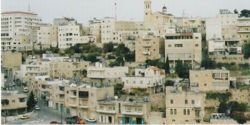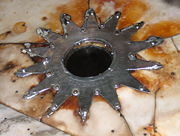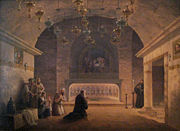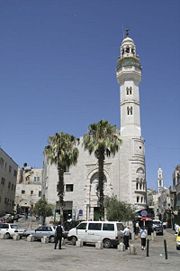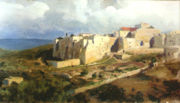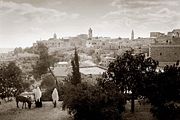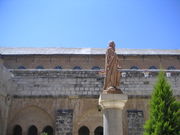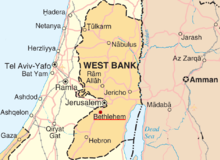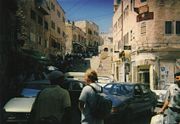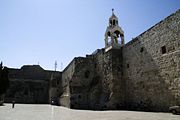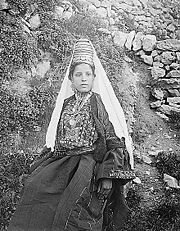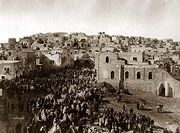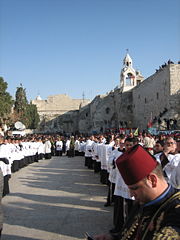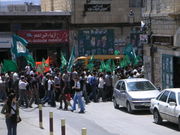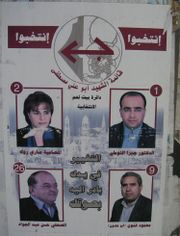Bethlehem
2008/9 Schools Wikipedia Selection. Related subjects: Asia; Asian Cities
| Bethlehem | ||
|
||
| Arabic | بيت لحم | |
| Name Meaning | house of meat (Arabic); house of bread (Hebrew) | |
| Government | City (from 1995) | |
| Also Spelled | Beit Lahm (officially) Bayt Laham (unofficially) |
|
| Governorate | Bethlehem | |
| Coordinates | Coordinates: | |
| Population | 29,930 (2006) | |
| Jurisdiction | dunams | |
| Head of Municipality | Victor Batarseh | |
Bethlehem (Arabic: بيت لحم, Bayt Laḥm , lit "House of Meat"; Greek: Βηθλεέμ Bethleém; Hebrew: בית לחם, Beit Lehem, lit "House of Bread") is a Palestinian city in the central West Bank, approximately 10 kilometers (6 mi) south of Jerusalem, with a population of about 30,000 people. It is the capital of the Bethlehem Governorate of the Palestinian National Authority and a hub of Palestinian culture and tourism.
According to the New Testament, Bethlehem is the birthplace of Jesus of Nazareth. The town is inhabited by one of the oldest Christian communities in the world, though the size of the community has shrunk in recent years due to emigration. The city is also believed to be the birthplace of David and the location where he was crowned as the king of Israel. The city was sacked by the Samaritans in 529 AD, during their revolt, but was rebuilt by the Byzantine emperor Justinian I. Bethlehem was conquered by the Arab Caliphate of 'Umar ibn al-Khattāb in 637, who guaranteed safety for the city's religious shrines. In 1099, Crusaders captured and fortified Bethlehem and replaced its Greek Orthodox clergy with a Latin one. The Latin clergy were expelled after the city was captured by Saladin, the sultan of Egypt and Syria. With the coming of the Mamluks in 1250, the city's walls were demolished, and were subsequently rebuilt during the rule of the Ottoman Empire.
The Ottomans lost the city to the British during World War I and it was to be included in an international zone under the 1947 United Nations Partition Plan for Palestine. Jordan occupied the city in the 1948 Arab-Israeli War, and it was subsequently occupied by Israel in the 1967 Six Day War. Israel has retained control over the entrances and exits to Bethlehem, though day-to-day administration has been under the purview of the Palestinian National Authority since 1995.
Modern Bethlehem has a Muslim majority but is also home to one of the largest Palestinian Christian communities. The Bethlehem agglomeration includes the towns of Beit Jala and Beit Sahour, as well as the refugee camps of 'Aida and Azza. Bethlehem's dominant economic sector is tourism which is particularly high during the Christmas season as the city is a Christian pilgrimage centre, being home of the Church of the Nativity. Bethlehem has over thirty hotels and three hundred handicraft work shops, employing several of the city's residents. Rachel's Tomb, an important Jewish holy site, is located at the entrance of Bethlehem.
History
Biblical era
Bethlehem, located in the "hill country" of Judah, may be the same as the Biblical Ephrath, which means "fertile": There is a possible reference to it as Beth-Lehem Ephratah. It is also known as Beth-Lehem Judah, and "the city of David". It is first mentioned in the Tanakh and the Bible as the place where the Abrahamic matriarch Rachel died and was buried "by the wayside" (Gen. 48:7). Rachel's Tomb, the traditional grave site, stands at the entrance to Bethlehem. According to the Book of Ruth, the valley to the east is where Ruth of Moab gleaned the fields and returned to town with Naomi. Bethlehem is the traditional birthplace of David, the second king of Israel, and the place where he was anointed king by Samuel. It was from the well of Bethlehem that three of his warriors brought him water when he was hiding in the cave of Adullam.
Birthplace of Jesus
Two accounts in the New Testament describe Jesus as born in Bethlehem. According to the Gospel of Luke, Jesus's parents lived in Nazareth but traveled to Bethlehem for the census of 6 AD, and Jesus was born there before the family returned to Nazareth.
The Gospel of Matthew account implies that the family already lived in Bethlehem when Jesus was born, and later moved to Nazareth. Matthew reports that Herod the Great, told that a 'King of the Jews' has been born in Bethlehem, ordered the killing of all the children aged two and under in the town and surrounding areas. Jesus's earthly father Joseph is warned of this in a dream, and the family escapes this fate by fleeing to Egypt and returning only after Herod has died. But being warned in another dream not to return to Judea, Joseph withdraws the family to Galilee, and goes to live in Nazareth
Early Christians interpreted a verse in the Book of Micah as a prophecy of the birth of the Messiah in Bethlehem. Many modern scholars question whether Jesus was really born in Bethlehem, and suggest that the different Gospel accounts were invented to present the birth of Jesus as fulfillment of prophecy and imply a connection to the lineage of King David. The Gospel of Mark and the Gospel of John do not include a nativity narrative or any hint that Jesus was born in Bethlehem, and refer to him only as being from Nazareth.. In a 2005 article in Archaeology magazine, archaeologist Aviram Oshri pointed to the absence of evidence of settlement of the area at the time when Jesus was born, although that has been disputed by many other scholars in the field.
The antiquity of the tradition of Jesus' birth in Bethlehem is attested by the Christian apologist Justin Martyr (c. 100 - 165), who noted in his Dialogue with Trypho that the Holy Family had taken refuge in a cave outside of town. Origen of Alexandria ( 185 - ca. 254) referred to a cave which was being pointed out as the birthplace of Jesus.
The first basilica on this site was begun by Saint Helena, the mother of the Emperor Constantine I. Under the supervision of Bishop Makarios of Jerusalem, the construction was completed in 333, and became what is known today as the Basilica of the Nativity.
Roman and Byzantine periods
Between 132-135 the city was occupied by the Romans after its capture during the Bar Kokhba Revolt. Its Jewish residents were expelled by the military orders of Hadrian. While ruling Bethlehem, the Romans built a shrine to the mythical Greek cult figure Adonis on the site of the Nativity. A church was erected in 326, when Helena, the mother of the first Byzantine emperor Constantine, visited Bethlehem.
During the Samaritan revolt of 529, Bethlehem was sacked and its walls and the Church of the Nativity destroyed, but they were soon rebuilt on the orders of the Emperor Justinian I. In 614, the Persian Sassanid Empire invaded Palestine and captured Bethlehem. A story recounted in later sources holds that they refrained from destroying the church on seeing the magi depicted in Persian clothing in a mosaic.
Islamic rule and the Crusades
In 637, shortly after Jerusalem was captured by the Muslim armies, 'Umar ibn al-Khattāb, the second Caliph visited Bethlehem and promised that the Church of the Nativity would be preserved for Christian use. A mosque dedicated to Umar was built upon the place in the city where he prayed, next to the church. Bethlehem then passed from the control of the Islamic caliphates of the Rashidun, the Ummayads, Abbasids and the Fatimids. In 1009, during the reign of the sixth Fatimid Caliph al-Hakim bi-Amr Allah, the Church of the Nativity was demolished under his orders. It was soon rebuilt by his successor Ali az-Zahir to mend relations between the Fatimids and the Byzantine Empire.
In 1099, Bethlehem was captured by the Crusaders, who fortified it and built a new monastery and cloister on the north side of the Church of the Nativity. The Greek Orthodox clergy were removed from their Sees and replaced with Latin clerics. Up until that point the official Christian presence in the region was Greek Orthodox. On Christmas Day 1100 Baldwin I, first king of the Frankish Kingdom of Jerusalem, was crowned in Bethlehem, and that year a Latin episcopate was also established in the town.
In 1187, Saladin, the Sultan of Egypt and Syria who led the Muslim Ayyubids, captured Bethlehem from the Crusaders. The Latin clerics were forced to leave, allowing the Greek Orthodox clergy to return. Saladin agreed to the return of two Latin priests and two deacons in 1192. However, Bethlehem suffered from the loss of the pilgrim trade, as there was a sharp decrease of European pilgrims.
William IV, Count of Nevers had promised the Christian bishops of Bethlehem that if Bethlehem should fall under Muslim control, he would welcome them in the small town of Clamecy in present-day Burgundy, France. As such, The Bishop of Bethlehem duly took up residence in the hospital of Panthenor, Clamecy in 1223. Clamecy remained the continuous ' in partibus infidelium' seat of the Bishopric of Bethlehem for almost 600 years, until the French Revolution in 1789.
Bethlehem — along with Jerusalem, Nazareth and Sidon — was briefly ceded to the Crusader Kingdom of Jerusalem by a treaty between Holy Roman Emperor Frederick II and Ayyubid Sultan al-Kamil in 1229, in return for a ten-year truce between the Ayyubids and the Crusaders. The treaty expired in 1239 and Bethlehem was recaptured by the Muslims in 1244.
In 1250, with the coming to power of the Mamluks under Rukn al-Din Baibars, tolerance of Christianity declined; the clergies left the city, and in 1263 the town walls were demolished. The Latin clergy returned to Bethlehem the following century, establishing themselves in the monastery adjoining the Basilica of the Nativity. The Greek Orthodox were given control of the basilica and shared control of the Milk Grotto with the Latins and the Armenians.
Ottoman and Egyptian era
From 1517, during the years of Ottoman control, custody of the Basilica was bitterly disputed between the Catholic and Greek Orthodox churches. From 1831 to 1841, Palestine was under the rule Muhammad Ali Dynasty of Egypt. During this period, the town suffered an earthquake as well as the destruction of the Muslim quarter by Egyptian troops, apparently as a reprisal for the murder of a favored loyalist of Ibrahim Pasha.
In 1841, Bethlehem came under Ottoman rule once more and remained so until the end of the World War I. Under the Ottomans, Bethlehem's inhabitants faced unemployment, compulsory military service and heavy taxes, resulting in mass emigration particularly to South America.
Twentieth century
As a result of their victory in World War I, the Allies, particularly Britain and France, divided the captured Ottoman provinces into mandates. On September 29, 1923 Bethlehem and the majority of the territory west of the Jordan River fell under the control of the British Mandate of Palestine. In the United Nations General Assembly's 1947 resolution to partition Palestine, Bethlehem was included in the special international enclave of Jerusalem to be administered by the United Nations.
Jordan occupied the city during the 1948 Arab-Israeli War. Many refugees from areas captured by Israeli forces in 1947-48 fled to the Bethlehem area, primarily settling in the what became the official refugee camps of 'Azza (Beit Jibrin) and 'Aida in the north and Dheisheh in the south. The influx of refugees significantly transformed Bethlehem's Christian majority into a Muslim one.
Jordan retained control of the city until the Six-Day War in 1967, when Bethlehem was occupied by Israel, along with the rest of the West Bank. On December 21, 1995, Israeli troops withdrew from Bethlehem, and three days later the city came under the complete administration and military control of the Palestinian National Authority in conformance with the Interim Agreement on the West Bank and the Gaza Strip in 1995.
Second Intifada
During the Second Palestinian Intifada, which began in 2000-01, Bethlehem's infrastructure and tourism industry was severely damaged. In 2002, it was a primary combat zone in Operation Defensive Shield, a major military offensive by the Israeli Defense Forces (IDF).
During the operation, the IDF besieged the Church of the Nativity, where about 200 Palestinians, including a group of militants, sought refuge amid IDF advancements into the city. The siege lasted for thirty nine days and nine militants and the church's bellringer were killed. It ended with an agreement to exile thirteen of the wanted militants to various European nations and Mauritania. Pope John Paul II condemned Israel's actions, describing them as reaching "unimaginable and intolerable" levels and the United Kingdom's foreign ministry stated they were "totally unacceptable".
Geography
Bethlehem stands at an elevation of about 775 meters (2,543 ft) above sea level, 30 meters (98 ft) higher than nearby Jerusalem. Bethlehem is situated on the southern portion in the Judean Mountains.
The city is located 73 kilometers (45 mi) northeast of Gaza and the Mediterranean Sea, 75 kilometers (47 mi) west of Amman, Jordan, 59 kilometers (37 mi) southeast of Tel Aviv, Israel and 10 kilometers (6 mi) south of Jerusalem. Nearby cities and towns include Beit Safafa and Jerusalem to the north, Beit Jala to the northwest, Husan to the west, al-Khadr and Artas to the southwest, and Beit Sahour to the east. Beit Jala and the latter form an agglomeration with Bethlehem and the Aida and Azza refugee camps are located within the city limits.
Old city
In the centre of Bethlehem, is its old city. The old city consists of eight quarters, laid out in a mosaic style, forming the area around the Manger Square. The quarters, include the Christian al-Najajreh, al-Farahiyeh, al-Anatreh, al-Tarajmeh, al-Qawawsa and Hreizat quarters and al-Fawaghreh — the only Muslim quarter. Most of the Christian quarters are named after the Arab Ghassanid clans that settled there. Al-Qawawsa Quarter was formed by Arab Christian emigrants from the nearby town of Tuqu' in the 18th century. There is also a Syriac quarter outside of the old city, whose inhabitants originate from Midyat in Kurdistan. The total population of the old city is about 5,000.
Climate
Bethlehem has a Mediterranean climate, with hot and dry summers and cold winters. Temperatures in the winter season, from mid-December to mid-March, could be cold and rainy. January is the coldest month, with temperatures ranging from 1 to 13 degree Celsius (33°–55 °F). From May through September, the weather is warm and sunny. August is the hottest month, with a high of 27 degrees Celsius (81°–63 °F). Bethlehem receives an average of 700 millimeters (27.6 in) of rainfall annually, 70% between November and January.
Bethlehem's average annual relative humidity is 60% and reaches its highest rates between January and February. Humidity levels are at their lowest in May. Night dew may occur in up to 180 days per year. The city is influenced by the Mediterranean Sea breeze that occurs around mid-day. However, Bethlehem is affected also by annual waves of hot, dry, sandy and dust Khamaseen winds that originate from the Arabian Desert, during April, May and mid-June.
Demographics
Population
| Year | Population |
|---|---|
| 1945 | 8,820 |
| 1961 | 22,450 |
| 1983 | 16,300 |
| 1997 | 21,930 |
| 2004 (Projected) | 28,010 |
| 2005 (Projected) | 29,020 |
| 2006 (Projected) | 29,930 |
According to a PCBS estimate, Bethlehem had a population of 29,930 in mid-year 2006. In the PCBS's 1997 census, the city had a population of 21,670, including a total of 6,570 refugees, accounting for 30.3% of the city's population. In 1998, the religious makeup of the city was 67% Sunni Muslim and 33% Christian, mostly of the Greek Orthodox and Roman Catholic denominations. In 2005, the total Christian population decreased to about 20%. Despite Islam being Bethlehem's dominant religion, the only Muslim house of worship in the city is the Mosque of Omar located in the Manger Square.
In 1997, the age distribution of Bethlehem's inhabitants was 27.4% under the age of 10, 20% from 10 to 19, 17.3% from 20-29, 17.7% from 30 to 44, 12.1% from 45-64 and 5.3% above the age of 65. There were 11,079 males and 10,594 females.
Christian population
The majority of Bethlehem's Christian inhabitants claim ancestry from Arab Christian clans from the Arabian Peninsula, including the city's two largest: al-Farahiyya and an-Najajreh. The former claims to have descended from the Ghassanids who migrated from Yemen to the Wadi Musa area in present-day Jordan and an-Najajreh descend from the Arabs of Najran in the southern Hejaz. Another Bethlehem clan, al-Anantreh, also trace their ancestry to the Arabian Peninsula.
The percentage of Christians in Bethlehem has been steadily falling, primarily due to continuous emigration. The lower birth rate among Christians as compared to Muslims also accounts for some of the decline. In 1947, Christians made up 75% of the population, but by 1998 this figure had dropped to 33%. The current mayor of Bethlehem, Dr. Victor Batarseh told the Voice of America that, "due to the stress, either physical or psychological, and the bad economic situation, many people are emigrating, either Christians or Muslims, but it is more apparent among Christians, because they already are a minority."
Palestinian Authority rule following the Interim Agreements is officially committed to equality for Bethlehem area Christians, although there have been a few incidents of violence against them by the Preventive Security Service and militant factions. The outbreak of the Second Intifada and the resultant decrease in tourism has also affected the Christian minority, leaving many economically stricken as they are the owners of many Bethlehem hotels and services which cater to foreign tourists. A statistical analysis of why Christians are leaving the area blamed the lack of economic and educational opportunities, especially due to the Christians' middle-class status and higher education.
A 2006 poll of Bethlehem's Christians conducted by the Palestinian Centre for Research and Cultural Dialogue, found that 90% reported having Muslim friends, 73.3% agreed that the Palestinian National Authority treats Christian heritage in the city with respect and 78% attributed the ongoing exodus of Christians from Bethlehem to the Israeli travel restrictions in the area.
The Hamas government's official position has been to support the city's Christian population, though the party has been criticized by some anonymous residents for increasing the Islamic presence in the city by, for example, activating the call to prayer at a previously unused local mosque in a Christian neighbourhood. Under Hamas, the Christian population has continued to suffer from a lack of law and order which has left it susceptible to land theft by local mafia who take advantage of ineffective courts and the perception that the Christian population is less likely to stand up for itself.
Economy
Shopping and industry
Shopping is a major sector in Bethlehem, especially during the Christmas season. The city's main streets and old markets are lined with shops selling handicrafts, Middle Eastern spices, jewelry and oriental sweets such as baklawa.
The tradition of making handicrafts in the city dates back to its founding. Numerous shops in Bethlehem sell olive wood carvings — for which the city is renowned — made from the local olive groves. The carvings are the main product purchased by tourists visiting Bethlehem. Religious handicrafts are also a major industry in Bethlehem, and some products include ornaments handmade from mother-of-pearl, as well as olive wood statues, boxes, and crosses. The art of creating mother-of-pearl handicrafts was introduced to Bethlehem by Franciscan friars from Damascus during the 14th century. Stone and marble-cutting, textiles, furniture and furnishings are other prevalent industries. Bethlehem also produces paints, plastics, synthetic rubber, pharmaceuticals, construction materials and food products, mainly pasta and confectionery.
Bethlehem has a wine-producing company, Cremisan Wine, founded in 1885, that currently exports wine to several countries. The wine is produced by monks in the Monastery of Cremisan, and the majority of the grapes are harvested from the al-Khader area. The monastery's wine production is around 700,000 liters per year.
Tourism
Tourism is Bethlehem's primary industry and unlike other Palestinian localities before 2000, the majority of the working residents did not work in Israel. Over 25% of the working population was employed directly or indirectly in the industry. Tourism accounts for approximately 65% of the city's economy and 11% of the Palestinian National Authority.
The Church of the Nativity is one of Bethlehem's major tourist attractions and a magnet for Christian pilgrims. It stands in the centre of the city — a part of the Manger Square — over a grotto or cave called the Holy Crypt, where Jesus was born. Nearby is the Milk Grotto where Jerome spent thirty years translating the Hebrew Scriptures into Latin.
There are over thirty hotels in Bethlehem. Jacir Palace, built in 1910 near the church, is one of Bethlehem's most successful hotels and its oldest. It was closed down in 2000 due to the violence of the Second Intifada, but reopened in 2005.
Economic conference
Bethlehem hosted the largest ever economic conference in the Palestinian territories on May 21, 2008. It was initiated by Palestinian Prime Minister and former Finance Minister Salam Fayyad to convince over 1,000 businessmen, bankers and government officials from throughout the Middle East to invest in the West Bank and Gaza Strip, although Fayyad admitted the territories were "far from the perfect business environment", being directly linked with the Israeli-Palestinian conflict. Nonetheless, 1.4 billion US dollars was secured for business investments in the Palestinian territories.
Culture
Embroidery
Before the establishment of Israel as a state, Bethlehem costumes and embroidery were popular in villages throughout the Judaean Hills and the coastal plain. The women embroiderers of Bethlehem and the neighboring villages of Beit Jala and Beit Sahour were known to be professional producers of wedding costumes. Bethlehem was a centre for embroidery producing a "strong overall effect of colors and metallic brilliance."
Less formal dresses in Bethlehem were generally made of indigo fabric and a sleeveless coat (bisht), made from locally woven wool, was worn over top. Dresses for special occasions were made of striped silk with winged sleeves and the short taqsireh jacket, known throughout Palestinian as the Bethlehem jacket, was worn over it. The taqsireh was made of velvet or broadcloth, usually with heavy embroidery.
Bethlehem work was unique in its use of couched gold or silver cord, or silk cord onto the silk, wool, felt or velvet used for the garment, to create stylized floral patterns with free or rounded lines. This technique was used for "royal" wedding dresses (thob malak), taqsirehs and the shatwehs worn by married women. It has been traced by some to Byzantium, and by others to the more formal costumes of the Ottoman Empire's elite. As Bethlehem was a Christian village, local women were also exposed to the detailing on church vestments with their heavy embroidery and silver brocade.
Museums
Bethlehem has four museums located within its municipal borders. The Crib of the Nativity Theatre and Museum offers visitors 31 3D models depicting the significant stages of the life of Jesus. Its theatre presents a 20-minute animated show. The Badd Giacaman Museum, located in the Old City of Bethlehem, dates back to the 18th century and is primarily dedicated to the history and process of olive oil production.
Baituna al-Talhami Museum, established in 1972, contains displays of the culture of Bethlehem's inhabitants. The International Museum of Nativity was designed by United Nations Educational, Scientific and Cultural Organization (UNESCO) for the purpose of showing works of "high artistic quality in an evocative atmosphere".
Cultural centers
Bethlehem is home to the Palestinian Heritage Centre, established in 1991. The centre aims to preserve and promote Palestinian embroidery, art and folklore. The International Center of Bethlehem is another cultural centre that concentrates primarily on the culture of Bethlehem. It provides language and guide training, woman's studies and arts and crafts displays, and training.
A branch of the the Edward Said National Conservatory of Music is located in Bethlehem and has about 500 students. Its primary goals are to teach children music, train teachers for other schools, sponsor music research, and the study of Palestinian folklore music.
Christmas celebrations
Christmas rites are held in Bethlehem on three different dates: December 24 is the traditional date by the Roman Catholic and Protestant denominations, but Greek, Coptic and Syrian Orthodox Christians celebrate Christmas on January 6 and Armenian Orthodox Christians on January 19. Most Christmas processions pass through Manger Square, the plaza outside the Basilica of the Nativity. Catholic services take place in St. Catherine's Church and Protestants often hold services at Shepherds' Fields.
Government
Bethlehem is the muhfaza (seat) or district capital of the Bethlehem Governorate. The Bethlehem Municipal Council consists of fifteen elected members, including the mayor and deputy mayor. A special statute requires that the mayor and a majority of the municipal council must be Christian, while the remainder are open seats, not restricted to any religion.
There are several branches of political parties on the council, including Communist, Islamist, and secular. The leftist factions of the Palestine Liberation Organization (PLO) such as the Popular Front for the Liberation of Palestine (PFLP) and the Palestinian People's Party (PPP) usually dominate the reserved seats. Hamas gained the majority of the open seats in the 2005 Palestinian municipal elections.
Elected Candidates of the Bethlehem municipal elections of 2005
| Rank | List | Candidate name | Religion |
| 1 | Brotherhood & Development ( PFLP) | Victor Batarseh | † |
| 2 | United Bethlehem ( Fatah and PPP) | Antun Salman | † |
| 3 | Reform ( Hamas) | Hasan al-Masalma | ☪ |
| 4 | United Bethlehem ( Fatah and PPP) | Afram Asmari | † |
| 5 | Wafaa ( Palestinian Islamic Jihad) | Isa Zawahara | ☪ |
| 6 | United Bethlehem ( Fatah and PPP) | Khalil Chawka | ☪ |
| 7 | Reform ( Hamas) | Khalid Jadu | ☪ |
| 8 | Hope & Labour ( Fatah) | Zughbi Zughbi | † |
| 9 | Reform ( Hamas) | Nabil al-Hraymi | ☪ |
| 10 | Reform ( Hamas) | Salih Chawka | ☪ |
| 11 | Reform ( Hamas) | Yusuf al-Natsha | ☪ |
| 12 | Brotherhood & Development ( PFLP) | Nina 'Atwan | † |
| 13 | Brotherhood & Development ( PFLP) | George Sa'ada | † |
| 14 | Independent | Nadir al-Saqa | † |
| 15 | United Bethlehem ( Fatah and PPP) | Duha al-Bandak | † |
Mayors
The mayor and the deputy mayor of Bethlehem are required by municipal law to be Christian.
|
|
Education
According to the Palestinian Central Bureau of Statistics (PCBS), in 1997, approximately 84% of Bethlehem's population over the age of 10 was literate. Of the city's population, 10,414 were enrolled in schools (4,015 in primary school, 3,578 in secondary and 2,821 in high school). About 14.1% of high school students received diplomas. There were 135 schools in the Bethlehem Governorate in 2006; 100 run the Education Ministry of the Palestinian National Authority, seven by the United Nations Relief and Works Agency (UNRWA) and 28 were private.
Bethlehem is home to Bethlehem University, a Catholic Christian co-educational institution of higher learning founded in 1973 in the Lasallian tradition, open to students of all faiths. Bethlehem University is the first university established in the West Bank, and can trace its roots to 1893 when the De La Salle Christian Brothers opened schools throughout Palestine and Egypt.
Transportation
Bus service
Bethlehem has four privately owned bus stations which offer service to Jerusalem, Hebron, Nahalin, Battir and Beit Fajjar. Buses and taxis with West Bank licenses are not allowed to enter Israel, including Jerusalem, without a permit.
Movement restrictions
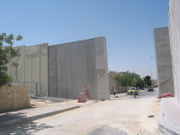
The Israeli construction of the West Bank barrier has had an impact on Bethlehem politically, socially, and economically. The barrier runs along the northern side of the town's built-up area, within meters of houses in 'Aida refugee camp on one side, and the Jerusalem municipality on the other.
Most entrances and exits from the Bethlehem agglomeration to the rest of the West Bank are currently subject to Israeli checkpoints and roadblocks. The level of access varies based on Israeli security directives. Travel for Bethlehem's Palestinian residents from the West Bank into Israeli-annexed Jerusalem is regulated by a permit-system. Acquiring such permits to enter, what in the past served in many ways as an urban anchor to Bethlehem, has become exceedingly rare since the onset of the violence surrounding the Second Intifada, though Israel has subsequently erected a terminal to ease transit between the two adjoining cities.
Palestinians are not allowed to enter the Jewish holy site of Rachel's Tomb, which is on the outskirts of the city, without a permit. Since Bethlehem and the nearby biblical Solomon's Pools lie in Area A (territory under both PNA military and civil administration), Israeli citizens are barred without a permit from the Israeli military authorities.
Sister cities
Bethlehem has the following sister cities.
|
|
